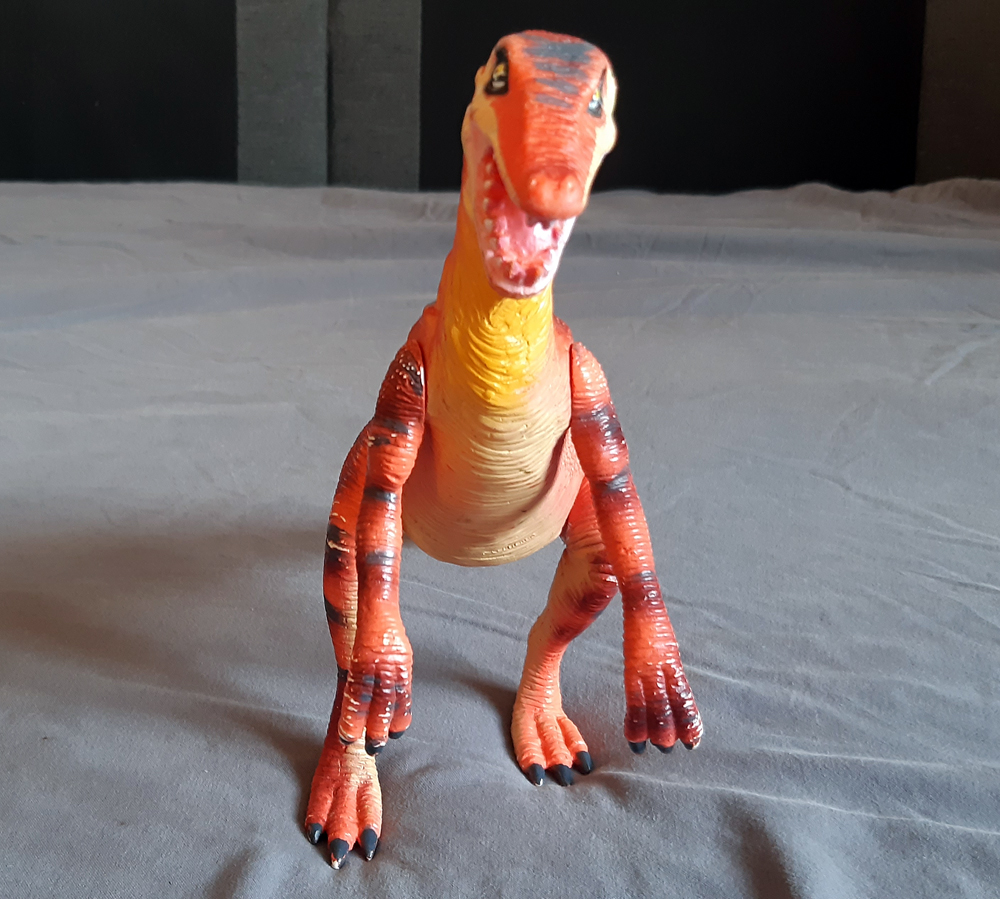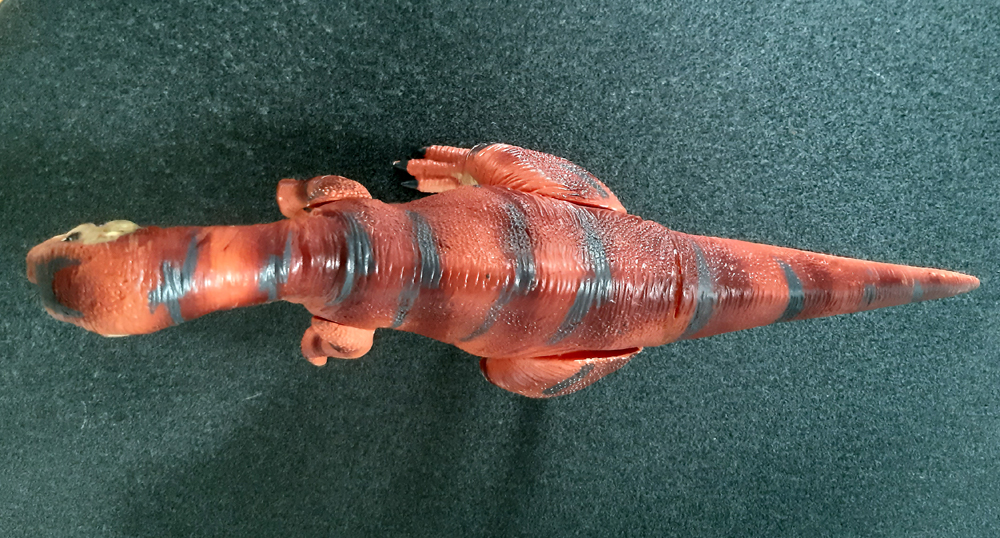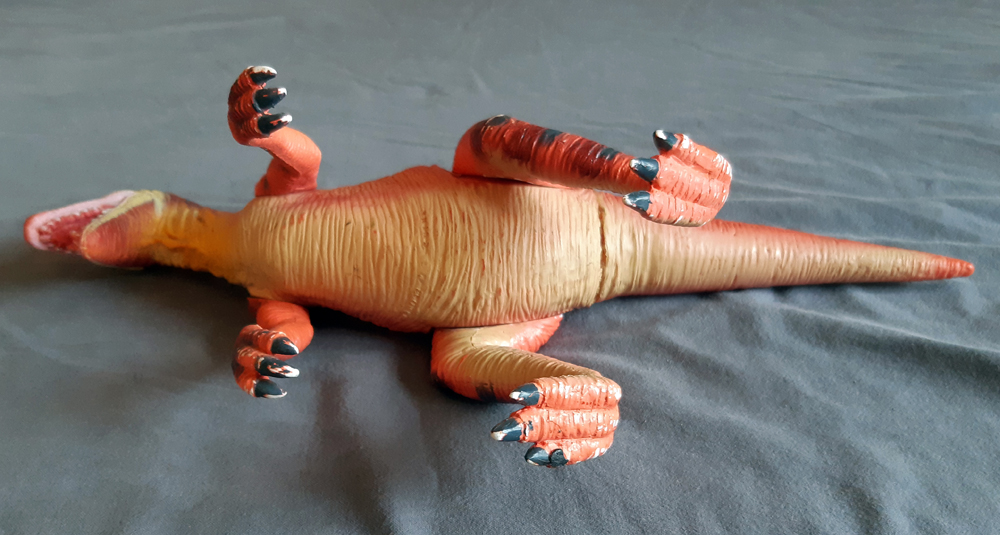Review and photographs by Funk, edited by Suspsy
This review is of a toy I distinctly remember seeing in a store and asking my mom to buy some time in the early 1990s’; it looked like a big, bad killer dinosaur, much fiercer than the others on the shelf. I always thought it was supposed to be an inaccurately proportioned Allosaurus or a similar large theropod (as it looked so evil and muscular), having discarded the packaging long before I could read. Fast forward to a few weeks ago, when I posted it for identification at the DinoToyForum, and it turned out it was the comparatively tiny Coelurus after all! This comes as a somewhat pleasant surprise, as the only other Coelurus toy I know of is the recent Jurassic World toy.

This figure was part of a line called Thunder-Beasts by the company Sky Kids, and has 1992 stamped on its belly. The toy was packaged with a small piece of fossil fragment from the Morrison Formation (where Coelurus is known from) that was authenticated by Henry Galiano, a fossil dealer who was formerly associated with the American Museum of Natural History. As a small kid, connecting this small piece of amorphous rock with a dinosaur was a bit of a stretch, so it soon disappeared, although I would, of course, have taken more care of it today. On the other hand, this piece was even smaller than the fossil bones that, if I recall correctly, paleontologist Jack Horner routinely smashed in front of his students to make the point that fossils collected without stratigraphic data are essentially useless for science.

This toy is pretty huge, about 35 cm from snout to tail tip, which would have contributed to me initially thinking it was supposed to be a huge theropod. The real Coelurus was, of course, rather small, about 2.4 m long, so the dinosaurs of this toy line were obviously not to scale. Furthermore, the toy has a really bulky body, very muscular upper arms and legs, and an extremely thick tail, all features that would indicate a huge animal rather than a small, lightly built one. On the other hand, the very long arms and fingers, coupled with the proportionately small skull and low, pointed snout, hints that this is supposed to be a small coelurosaurian theropod, as they were imagined at the time. But given what we now know, it should probably be covered in feathers, and it actually looks more like what have since been identified as megaraptoran theropods, with their long arms, large hands, and slender skulls with pointed snouts.

Since Coelurus is known from such scanty remains, there isn’t really much that would make one recognise this toy as being that genus, though the legs and arms seem to be proportionally long (the metatarsals of the lower leg should probably be more than double the length to match the fossils, though). The teeth are very large and triangular, whereas they would probably have been smaller and more recurved in the real animal. The front teeth are also larger than the rest, being similar to the incisors of mammals, when they probably should instead be some of the smallest teeth. It almost goes without saying for a figure this age that the hands are pronated, but a more unusual inaccuracy which can not be explained away by its age is that the feet lack dewclaws (halluxes), which are otherwise known in most theropods except ornithomimids.

What really makes this figure stand out is the colour scheme. It is mainly orange, with yellow running from its face down its neck, where it turns into a light sienna by the chest and to the tip of the tail. It has blackish stripes with faint borders running down the back and across the limbs, as well as black markings around the eyes which, when coupled with the yellow irises on what seem to be otherwise black eyeballs, make it look insane and diabolical. The arms and legs are able to rotate where they meet the body, which makes it possible to achieve some cool walking and slashing movements while playing, but the legs are posed in such a way that the figure can only stand up when they are in a specific position in relation to each other, and even then it needs to balance on its tail in order to be sure it won’t tip over. However, it is possible to make it stand up without relying on a tripodal pose, one just has to find the “sweet spot,” as shown in some of the pictures here, although a flat, stable surface is probably necessary for it to keep standing. Strangely, the feet don’t seem to have heels, and when seen from below, the lines that indicate the separation of the toes just stop abruptly, with no supporting footpad at the back.

Compared to the Jurassic World Coelurus, which seems to be the only other such toy in existence, this figure seems a bit too bulky compared to the nimble animal it depicts, but on the other hand, the JW Coelurus loses points for not being feathered, even when it was produced during a time when this was known to be inaccurate (and I don’t buy the argument that the scaly JP raptors set a precedence; even the new Indominus and Indoraptor designs have feather-like quills, not to mention the JP3 raptors, so consistency across the franchise has long been ignored anyway). The company behind the Thunder-Beasts toy did not have the luxury of this knowledge, so the lack of feathers can’t really be held against them, though the missing dewclaws are hard to defend.

I would recommend this toy simply for being one of the few (perhaps only one of two) Coelurus toys in existence, though it can’t really be said to have a good likeness to that dinosaur (even considering how little is known of it). If you sculpt a toy based on a dinosaur only known from limb bones and vertebrae, at least make the proportions match those few elements! And as stated earlier, when I played with it as a kid, I imagined it as being a large theropod, and it therefore acted as such in my scenarios. Its cool colour scheme somewhat makes up for these issues, if one has to find some justification for placing it on the mantle piece. It still seems to be sold in unopened boxes including the aforementioned fossil scrap, but I’m unsure if anyone would really be excited about a shapeless rock, even when knowing it was once part of some prehistoric animal.
Disclaimer: links to Ebay and Amazon on the DinoToyBlog are affiliate links, so we make a small commission if you use them. Thanks for supporting us!



